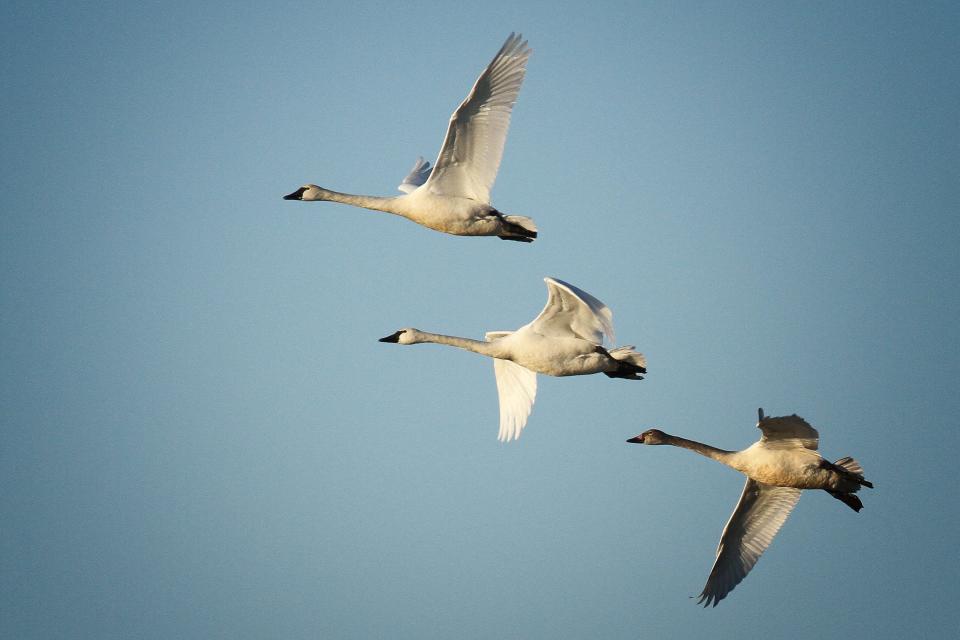Looking for swans in the Tri-State? Here's when and how to find them
North America is home to two native swans, tundra swans and trumpeter swans. Both nest in the high Arctic. Both migrate south for the winter. But according to published range maps, neither winters here. Wrong! They both do! And now's the time.
Tundra swans are more numerous with a 2015 USFWS census hitting about 173,000. Migrating about 4,000 miles each spring and fall, they fly in a V formation, and according to the American Bird Conservancy, as high as an astounding 26,000 feet, up to 100 mph. They call in flight, a sort of "how-hooo," sometimes heard here on clear autumn evenings. Once called whistling swans, the moniker reflected their in-flight wing noise. Their 1983 rename more accurately names what they are − residents of the tundra, where their growing populations threaten their food supply.
Trumpeter swans, however, come with an entirely different back story. They were extirpated from the Midwest by the late 1800s. Their all-white feathers and skins went to Europe to make women’s hats and powder puffs; their strong flight feathers, to craft superior quill pens. Outside the Midwest, though, a few hundred survived, scattered across remote wetlands in the Northwest through Alaska.
In 1959, only 1,914 trumpeters inhabited the U.S. By 2014, USFWS tallied over 63,000. The increase was aided between 1966 and 1980s by natural resource agencies' programs to reintroduce trumpeters to the Midwest. Now, banding results show that most trumpeters overwintering here result from those reintroductions. In fact, when we saw our first Indiana trumpeters in winter, 2009, they wore yellow neck bands that traced their heritage to great great grandparents in Wisconsin.

So while there were zero trumpeter swans in the Great Lakes area in 1985, now about 740 birds breed in Michigan, 700 in Wisconsin, and 1,000 in Ontario. All migrate south in winter. Although not listed as federally endangered, trumpeters are actually far more rare than bald eagles.
The biggest threats still facing both swan species include habitat loss, climate change, and lead poisoning. Oil and gas extraction in the high Arctic decimates habitat. Hunters' spent lead shot is scooped up by foraging swans feeding on the bottoms of rivers and lakes where hunting occurs. Along their migratory routes and on their wintering grounds, pollution and wetland loss top the list of threats.
What handsome birds, these swans: tall, long-necked, full-bodied, all-white gleaming plumage, black-billed, alert, majestic. So how can one know which is which?
Some comparisons: Trumpeters are by far our largest native waterfowl, standing four feet tall. At 35 pounds, these big guys outweigh their look-alike tundra-swan cousins by almost double. Tundras fly on a five-and-a-half foot wingspan while trumpeters add another foot − both powerful enough to keep a heavy bird aloft.
While bill shape, yellow spots at bill's base, and other minute details supposedly separate the two, by far, the easiest distinction is voice. Trumpeters do what their name says, in a deep sonorous voice. Tundras call in a high-pitched "woo."
Find tundras at Sauerheber Sloughs Management Area near Geneva, Kentucky, and trumpeters at Cane Ridge near Duke Energy cooling ponds in Gibson County. Sunset offers the most likely viewing times since swans come to roost in shallow waters.
For more about each swan, go to allaboutbirds.org and enter the name in the search box.
For more information about birds and bird habitat, see Sharon Sorenson's books How Birds Behave, Birds in the Yard Month by Month, and Planting Native to Attract Birds to Your Yard. Follow daily bird activity on Facebook at SharonSorensonBirdLady, or email her at chshsoren@gmail.com.
This article originally appeared on Evansville Courier & Press: Looking for swans in the Tri-State? Here's when and how to find them

